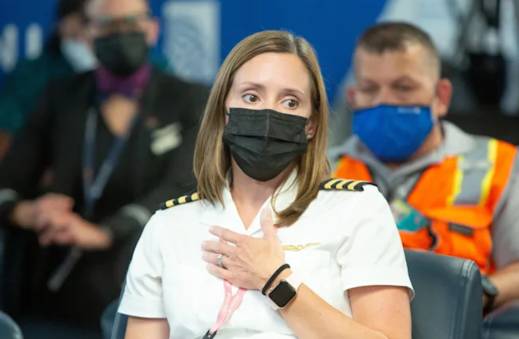In 17 ½ years as a flight attendant for United Airlines, Hope Williams has worked thousands of flights.
But one recent flight will stay with her forever.
Williams recalled the mixture of fear, uncertainty, relief and hope on the faces of hundreds of Afghan evacuees on the day they boarded the Boeing 777-300 that would take them from Qatar to Germany, then on to the United States.
She was part of a crew of more than a dozen United employees who volunteered to work on one of the first Afghan evacuee flights operated by the carrier. Williams said they tried to make those onboard feel comfortable, but it was clear the trauma of leaving Kabul was fresh. The stories they told and the bruises on their bodies brought tears to her eyes. But her time with them also brought something else.
“It’s like my name: Hope,” she said. “To know they were that much closer to being safe, it’s something I know I will never forget.”
Williams and her colleagues were among thousands of employees at six commercial U.S. carriers who played roles in the massive evacuation to get Americans and allies out of Taliban-controlled Afghanistan before the Biden administration’s deadline. The final evacuation flights departed early this week as the United States vacated Afghanistan and the besieged Kabul airport, handing control to the Taliban after two decades of war.
In the air and on the ground, airline employees say they served as translators and troubleshooters. They stocked planes with diapers and teddy bears for hundreds of evacuated children and dug into their own pockets if supplies were needed. They delivered pizza to those awaiting processing who were stuck on planes at Dulles International Airport outside Washington, prompting the business taking the order to proclaim with glee: “Y’all we’ve got a big one. American Airlines!” the airline wrote on its company blog.
Hours before Delta’s first flight carrying evacuees was scheduled to arrive Aug. 23 at Dulles, the airline received word that several dozen children were among those on board. Three airline employees hopped into a van to stock up on diapers, formula and baby snacks.
Since that time, Delta flew 18 evacuation flights, bringing about 4,600 evacuees to the United States. United flew 4,000 people to the U.S. on 13 evacuation flights.
In all, U.S. officials said 122,000 men, women and children were flown out of the country in the unprecedented airlift. Of that total, 79,000 were evacuated by American military aircraft; the rest on charter and allied military flights. As of Friday, Virginia Gov. Ralph Northam (D) said 14,000 Afghan evacuees had arrived in Virginia.
The effort included 18 planes from American Airlines, Atlas Air, Delta, Omni Air, Hawaiian Airlines and United. The aircraft were used to augment military flights under the Civil Reserve Air Fleet, a Department of Defense program created after World War II that allows the government to utilize commercial aircraft during a national defense crisis.
The commercial planes did not fly into Kabul’s Hamid Karzai International Airport, but ferried passengers from transit centers and U.S. military bases in nations such as Qatar, Germany, and the United Arab Emirates, where Afghans were processed for resettlement in other countries.
The first flights began landing in the U.S. last week. The vast majority touched down at Dulles, alongside reports that some evacuees were stuck on planes for as long as 12 hours as they waited to be screened and vetted by U.S. officials. The delays reflected the challenges of admitting thousands of people to the country in a short span of time.
The processing delays were largely resolved by the end of last week after officials opened more areas for evacuees to wait until they could be processed. One location, housed in a converted United maintenance hangar, proved spacious enough for some to play soccer – a reminder, employees said, that no matter where they land, kids will be kids.
Philadelphia International Airport began receiving flights over the weekend, relieving pressure on Dulles as the operation began to wind down.
United flight attendant David Rocca, who was with Williams on the flight from Qatar to Germany, said he was struck by how few possessions evacuees carried with them.
“No shoes, no luggage – just a few personal belongings in a plastic bag,” he said. It was a reminder, he said, of all they had left behind.
Monday evening, United Chief Executive Scott Kirby – in Washington for a meeting at the White House – met with a small group of employees at Dulles to praise their efforts.
“Thank you all so much from the bottom of my heart,” he said. “This is where we get the chance to do something that really makes a difference.”
Midway through the town hall, one employee reminded colleagues that stories seemingly far way can often hit close to home.
Mohammad Asif, who works at Dulles loading and unloading aircraft, is originally from Afghanistan and translated for the arriving evacuees. The former U.S. Marine translator told the room that he remains concerned for his wife, mother and younger sister and brother who are still in Afghanistan. He fears for their lives, he said, and hoped they could be helped.
Airline employees said being part of the evacuation effort lifted their spirits at a time when many have grown weary of the steady drumbeat of negative headlines: hurricanes, fires and the pandemic.
Mehdi Haririnia, a customer service supervisor with United who immigrated to the U.S. from Iran in 1988, served as a translator for arriving Afghans, helping to answer questions and explain the process new arrivals must follow after they land. The work, he said, reminded him that a friendly face speaking a familiar language can be calming, even in the midst of turmoil.
United pilot Jennifer Shields, who is helping to fly groups of evacuees to Wisconsin, where some will be housed at Fort McCoy, called the opportunity the most meaningful of her career.
Alaska Airlines announced last week it would fly evacuees to military bases across the country that will serve as temporary homes for evacuees. Pentagon spokesman John Kirby said the military is prepared to house up to 50,000 Afghans at seven bases and facilities in the U.S.
Williams recalled the family that sat in Row 34, seats A, B and C, that made multiple trips to the Kabul airport before finally getting through. Then there was the translator who made it through the gates, only to lose track of his family at the end. He sat on the airplane frantically trying to sign on to the free Wi-Fi in hopes he could locate them, but was not successful.
“Life-changing,” she said. “And humbling. Very humbling.”
Source: washingtonpost







